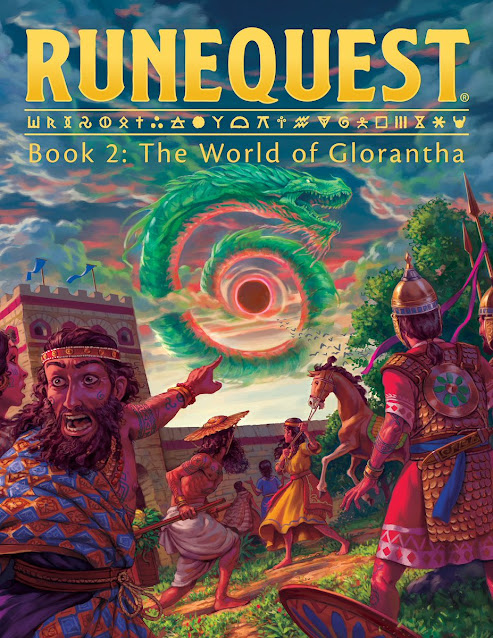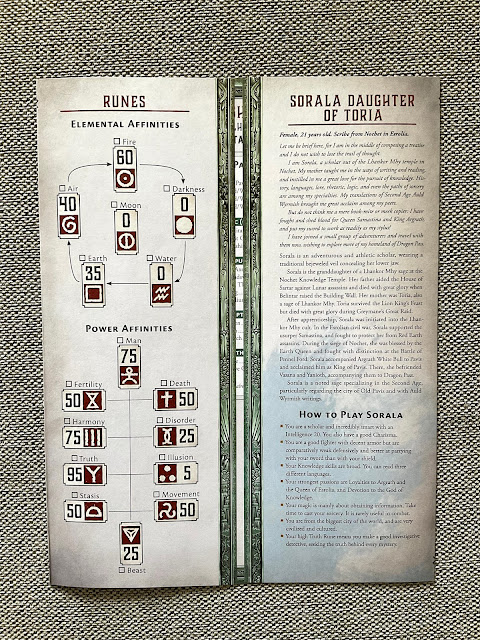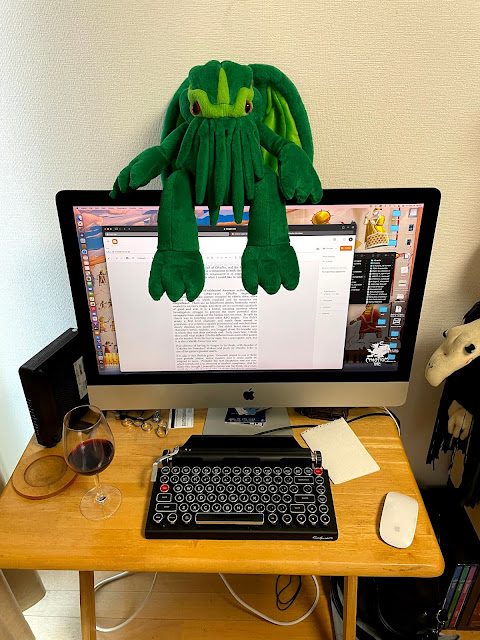The Problem, the Solution
HERE is the problem.
First published in 1978, Runequest is one of the oldest and most respected roleplaying games out there, frequently named after D&D as having exerted the greatest influence on the hobby. The current edition, Runequest Roleplaying in Glorantha is forty years in the making, drawing on not only the original editions but elements of subsequent games Runequest inspired. Runequest's setting, Glorantha, is legendary. It influenced authors like George R. R. Martin in shaping the world of the Song of Ice and Fire saga and Ken Rolston in helping create the world of The Elder Scrolls. In ranking RuneQuest at #5 in the fifty most popular roleplaying games of all time, Arcane magazine said
RuneQuest manages to establish itself as a cut above the rest because of its intricate and highly original campaign setting. [...] This is a world that combines high-fantasy heroism with the gritty realities of cross-humanoid racism and the problems of day-to-day living. The cults of the world, which play an intrinsic part of every adventurer's life, add to the mysticism of the game, and give it a level of depth which other fantasy systems can be but envious of...
Christmas Issue, 1996
So why would I call any of this a "problem?" Simply put,
Runequest's immense depth and breadth can be intimidating to new players,
especially potential game masters looking to run it. The
Runequest core rules are nearly 450 pages. Then there is the
Runequest Glorantha Bestiary and a GM's pack. Meanwhile, the
Glorantha Sourcebook is a svelte 220 pages, but the
Guide to Glorantha is 800+. The problem is compounded by old grognards like me who can (and if you have been reading this blog
do) opine endlessly on the minutia of the setting. Would-be players get the impression that to play
Runequest, you first need a PhD in it.
If only there were a single, streamlined product we could point new players to, a concise entry point that explained the rules, introduced the setting, and made it all effortless to learn and play. Something that showcased what makes this fantasy RPG unique.
Oh wait, now there is...
I. A Boxed Set
Like the
Call of Cthulhu Starter Set before it, the
Runequest Starter Set harkens back to the earliest days of the hobby, using a boxed set as the format for introducing the game to new players. The reasoning is simple. The boxed set format allows you to include everything needed to play--short of players and pencils--right there inside. Unlike the flimsy boxed sets I remember from my early days playing, the first thing that struck me was how sturdy the
Starter Set was. The heavy cardboard is designed to handle a bit of wear and tear.
Make sure you have space on your shelf. In both length and width the boxed set is considerably larger than the hardcover books in the line such as the core rules.
Once you open the lid you find a box crammed with goodies. Two immediately jump out at you, the dice included in the set and the top cover sheet explaining what the product is and everything you will find inside it.
First you get a full set of all the dice you need to play Runequest. As one might expect for a game set in a Bronze Age world (more on that below), they look a bit like bronze. For the record you find a D6 (six-sided die), D12, D8, D20, D4 and two percentile dice (ten-sided dice one with a tens number and the other with a ones).
The cover sheet has a "read me first" box that explains briefly what a roleplaying game is and what will be found in each of the books inside. Then you get a more detailed "what's in the box." We will be going over each of the contents in turn. Before we do, there is also a handy "what's not in this box" for long time players who might wonder what was omitted. For the record the Starter Set does not cover;
- Character creation
- Equipment (beyond that carried by the pregen characters)
- Advanced combat options (phalanxes, chariots)
- Rune Masters
- Sorcery and advanced Spirit World information
- Sacred Time phase rules
II. A Brief Detour Into Art
Before we get into the actual contents, a word needs to be said on art.
While the old adage tells us you can't judge a book by its cover, you actually can and most people do. One thing that has been a key element of the "new" Glorantha and Runequest since--by and large--the 2014 Guide to Glorantha has been the quality of the art. Over the last four decades art for Glorantha has been all over the place, something curiously at odds with a game that has such well defined cultures. There has been a real effort in the Runequest line since 2018 to be consistent in the depiction of these cultures, and to make them look unique (as opposed to, say, just fantasy Greeks or Celts or Vikings).
The Starter Set, beginning with Ossi Hiekkala's terrific cover, exemplifies this. The reason I mention the art here is that the moment you flip over the cover sheet you see a product listing for other titles in the Runequest line. Right beside this is an image of one of the pregenerated characters included in the set by the frankly amazing Loïc Muzy. Looking at the character, we immediately get a sense of the Bronze Age setting (the short slightly leaf-bladed sword, the shield, the armor) and the culture. We notice the use of tattooing or body painting, get a sense of ethnic identity (and one which is not immediately identifiable as an Earth culture, a trap previous incarnations of RQ have fallen into), etc. This is all critical, I think, for a boxed set whose mission is to introduce the game to new players. The art immediately makes it clear that this is not medieval fantasy Europe, or even really ancient fantasy Europe. More importantly, it draws you in and makes you want to explore.
III. Now Back to the Contents...the Rules Book
Let's be clear up front. The goal of the Starter Set is to introduce new players to the game, not to be something you create your own characters and campaigns with. For that, you will want Runequest Roleplaying in Glorantha. The boxed set then gives you a wide selection of pregenerated characters and all the rules you need to play them. It written in such a way as to ease those new to Glorantha into both the system and the setting.
Coming in at 61 pages, the Rules booklet starts with an introduction to Runequest and Glorantha, a light discussion of roleplaying games and the roles of GM and player, and a summary of the game system. I am not going into any depth on the actual mechanics in this review. In essence, Runequest is a skill-based system without anything like a character "class." Characters are defined by what they can do and what they know. If you know a spell you can cast it. If you have skill in a sword, you can swing it.
Most rolls are resolved with a percentile roll. Two ten-sided dice are rolled, one clearly marked as the "tens" and the other as the "ones." This number is compared to your percentage chance of performing the task. If you roll is equal to or under the value, you succeed. Degree of success can also matter. If you are curious, I've already talked about all that extensively
here.
What characters can do is defined by abilities. These are broken down into characteristics like Strength or Charisma, which measure raw talent and potential, skills which are learned abilities, passions which are strong emotions like love, loyalty, honor, or hate, and finally Runes (more on these in the next section). Most of these are rated in percentages, from zero to a hundred+. 7th edition Call of Cthulhu players take note; characteristics are not given in percentiles but on a scale of roughly 3 to 21. These are generally multiplied (x2, x3, x5) before rolled against.
The presentation of the rules in the Start Set is very aware this is likely the first time people have ever seen them, so they are clear, concise, and very to the point. Case in point, a skill like "Charm" is explained with about 80 words in the core rulebook, in the Starter Set is explained in ten. Like the core rulebook, when key terms are mentioned they are in boldface so as to make them easy to find. Nearly every section comes with an example of play.
The Rules booklet covers the use of abilities, improving from experience, combat, and magic. Magic in the game is divided into spirit magic, charms and spells powered by the caster's own magical energy or that of spirits bound to them, Rune magic which comes directly from the gods, and sorcery which is the manipulation of the Runes through established procedures. The Starter Set emphasizes that every character can, and should, use magic...something that makes Runequest different from the majority of fantasy RPGs out there.
Again, the art comes through as a very useful tool to simplify, illustrate, and explain things. In Runequest combat "hit locations" (where a blow actually lands on the body) is crucial, and this makes armor important. Because many potential players coming into the game will not be familiar with Bronze Age armor terminology, the following illustration helps clarify. The Starter Set is filled with art like this.
IV. The World of Glorantha
Glorantha is one of the first fantasy game settings, appearing alongside Greyhawk, Blackmoor, and Tékumel in 1975. It is almost certainly one of the most defined, with forty years of materials in print. If the inspiration for a world like Middle-earth was primarily linguistic--a place for Tolkien to build imaginary languages--Glorantha was born because Greg Stafford wanted to explore mythology. This is a Bronze Age world, bearing more in common with The Iliad, The Odyssey, or The Mahabharata than The Lord of the Rings or Le Morte d'Arthur. Instead of knights in shining armor think "heroes" and "priest-kings."
Glorantha is not a world like our Earth with a little magic thrown in. It is flat, stretching under a sky dome. The sun literally emerges from the gates of the underworld in the east, travels across heaven, and then descends through the gates of the west at night. The realm of the dead lies beneath your feet; great heroes can actually escape the underworld and return to the lands of the living.
Glorantha is defined by her magic, but this is deceptive if you are thinking of other fantasy worlds. The world, and everything in it, is composed of the Runes. These are to Glorantha what the periodic table is to chemistry, or phonemes are to language. Darkness, Water, Earth, Plant, Harmony, Death...these are the essences, the building blocks of existence. "Magic" in Glorantha is how your character relates to the Runes. It is often defined by culture and the magic you practice. Some see the Runes as living spirits, negotiating and bargaining with them. Some see them as impersonal forces of nature to be tapped into and directed via knowledge and will. Some see them as gods, mighty beings whose deeds in the mythic prehistory of the world shaped it. By sacrifice, the worshipper becomes one with them. None of these approaches is wrong.
The Starter Set is painfully aware that all the gods, all the mythology, all the history and lore makes Glorantha daunting to newcomers. So it condenses what you need to know to about 20 pages. Other rule sets have tried manage the overload by focusing on a single region of the world, usually Dragon Pass and neighboring Prax. The Starter Set narrows even further. It concentrates on the northern half of the principality of Sartar, a barbarian nation that worships a pantheon headed by a thunder god and his wife, the Earth Mother. These people have recently liberated themselves from the yoke of an invading northern Empire. Then it picks a single city, Jonstown, to go into detail on. It spends roughly 40 pages of the 61 page booklet on just this city, which detailed maps of its neighborhoods...
...and statistics and images of important residents.
For new players, and especially GMs, it has never been easier to "get into" Glorantha. By giving you just one region of one principality, and detailing one city in it, you have a very manageable base of operations to run the included adventures in. For long time players, the deviously cunning and vilely evil tempters at Chaosium know you will need this boxed set just for the gloriously illustrated and detailed look at Jonstown.
V. Soloquest
There is not THAT much I can say about the third booklet without giving the plot away. This is a solo adventure, meant for either a potential player or GM. You take on the role of Vasana, Daughter of Faran, and play through the famed "Battle of Dangerford," a battle I covered in The Company of the Dragon, Ian Cooper covered in The Eleven Lights, and Nick Brooke gave a take on in his Duel at Dangerford. It is a terrific choice because it is historic and takes place at the very start of the timeline in Runequest Roleplaying in Glorantha.
The book is a bit like the old classic "choose your own adventures," but by playing it it is actually teaching you the rules of Runequest as you go. It is fun, exciting, and by the time you emerge you will have a reasonable grasp of the game and the setting.
VI. Adventures
The fourth and final book is the longest, coming in at 81 pages. It includes three full adventures, A Rough Landing, A Fire in the Darkness, and The Rainbow Mounds all geared towards a first-time game master running them. Experienced GMs can of course use them too, but the additional support and advice makes it easy for beginners to do so. There is tons of support in here, including good reminders for even old hands at running the game. Following these is a chapter of rumours and gossip around Jonstown and adventure seeds that could be fleshed out.
VII. The Rest of the Content
Yes, I know what you are thinking. "Wait, stop Montgomery, stop. 260+ pages of fantasy RPG goodness, a full set of dice, and there is more?!?" Yes, gentle reader, would I lie to you?
The Pregenerated Characters
Instead of containing character creation rules, the Starter Set gives you 14 (!!!) pregenerated characters to chose from. These cover the gamut of characters one might expect in and around the city of Jonstown, acting in and of themselves as teaching tools by showing new players and GMs the kinds of characters that exist in Glorantha. These 14 each come on their own character "folios." I am not going to call them sheets. On one side each starts with a gorgeous full page illustration of the character...
...flipping this over you find two folded leafs showing the characters Runes and a description of them and how to play them...
...and these fold back to reveal the character sheet. And on that note, I am done talking about them. The accompanying pictures reveal how stunning they are.
The boxed set includes two blank versions of this character folio as well. Chaosium...if you are reading this, start selling packets of these please.
Maps
Rounding out the Starter Set are three gorgeous maps. The first is northern Sartar, the region around the city of Jonstown. The second is Jonstown itself. The third shows the Rainbow Mounds from one of the adventures.
Handouts and Play Aids
Finally, you get a collection of handouts and useful play aids, including handy combat tables and a description of the Runes. There is even a "Strike Rank" tracker (used to measure who goes first in a Runequest combat round) that I will definitely now be using in my games.
Final Thoughts
There has never really been a product like this for Runequest, or any other form of Gloranthan gaming for that matter. Priced at around $30 US (if Amazon is to be believed) this is simply the best single introduction to the game and setting we have seen. Long time players are going to want it for Jonstown, the extra play aids, and a few really excellent adventures. But they are also going to want to give it to friends as birthday gifts and the like to try and show them what Runequest is and why we love it. Gamers curious about Glorantha, but put off by the depth and immensity of it all, will want this product as something that shows them exactly why Runequest and Glorantha are so talked about and famous. For little investment of time and money, they can jump right into the setting and decide if it is for them.
The boxed set is loaded. Even ridiculously so. Even the backs of the four books are put to use, forming a map...
...all for just pennies per page. If you have ever been even mildly curious about Glorantha or Runequest, here is your chance to explore. You will know exactly after exploring the Starter Set if this is the game for you.


















